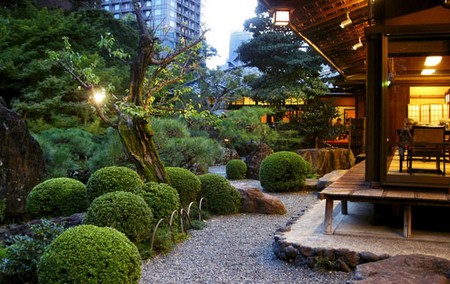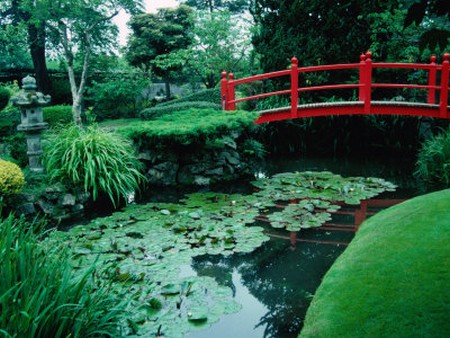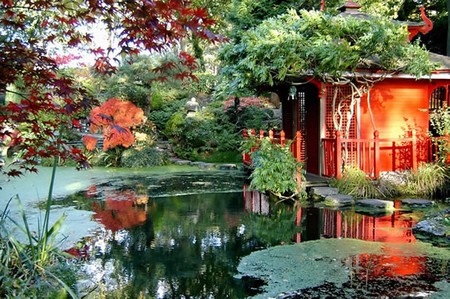The main design feature of Japanese-style garden is the geometric layout of the floor, and several different materials have been used to create patterns of wood, bricks, gravel and stone. Water, light and a few carefully chosen feature plants are then used to contrast with and complement this geometric pattern. It is not only the different surfaces that give each area its distinctive character, however, but the ways in which they are laid out. The brick, wood and gravel will look subtly different in wet or dry weather.
The unity and small scale of the design mean that materials can be combined to appear natural and harmonious, but the scheme also makes it possible to include greater variety in a small area. An individual and strong design statement, this garden offers quiet sanctuary and peace. It has an uncluttered feel yet contains many elements that are united and tied together.
Strong design, using visually striking hard landscaping, is traditional in Eastern gardens and is used here to great effect. Every single feature and plant has earned its place and is carefully chosen and sited. Every element is important and forms a focal point in its own right. The garden has drama, character and individuality and suggests a strong, calm personality.
Features
While Western gardens concentrate on introducing curves to create a relaxed feel, in an Eastern garden it is the configuration of geometrical patterns in precise and ordered arrangements that creates an harmonious space. Many small areas, each contrasting with its neighbours, are created within the garden. As important as the features is the space between them, and the placing of individual plants and artefacts is crucial to the overall scheme. Nothing is complicated, and the simplicity and clean lines add to the sense of care and search for perfection.
The patio is laid in a symmetrical pattern of bricks and has a few plants in containers. The pots contain seasonal plants and there is a stunning Phormium ‘Dazzler’ as a focal point at the end of the garden. The L-shaped pool around the seating area is crossed by two simple wooden bridges, which neatly take you into other areas. A pump feeds water into the canal, and the small change in level produces a gentle waterfall. The water acts like a mirror, reflecting and bringing movement and light into the garden.
The interplay of materials is emphasized by using timber slats set in a base of gravel to contrast with the brickwork and fencing in a series of geometric shapes. The gravel is largely bare, except for a few carefully placed, interesting plants, and the small tree will provide shade in this sunny area.
This area is linked to the neighbouring shady area by the wooden slats and a line of bricks set in the gravel. A tiny arbour, created in a covered pergola, is set against the wall. A short flight of steps leads into another shady area, which is both defined and linked to the patio by the use of the same bricks, and another simple wooden bridge takes you back to the seating area, completing the unity of the garden. There are no loose ends: absolutely everything is linked and tied together, making the garden a place of peace and harmony.
The tall bamboo screen adds to the oriental feel, and a stone statue has been chosen for its form to add to the composition.
The furniture is limited to a table and chairs on the spacious patio and to a bench tucked away inside the covered pergola.
Planting
In keeping with the ambience created by the hard landscaping, the planting is simple but carefully chosen and positioned. To create an Eastern feel, hardy but exotic-looking plants in pots are used. A few well-placed, strong, spiky plants will give an impression of coming from faraway places.
The shape and form of the plants is as important as those of the features. A single ivy climbs the fence to provide a subtle green backdrop, but the wooden fencing is kept largely bare to allow the wood to be appreciated for its natural beauty and subtly lend its properties to the garden.
A few containers are used to take plants into areas where they are needed. A single container on a square stone against the wall provides a small focal point. Low shrubs backed with climbers add richness to the shaded part of the garden, and the rectangular beds in front of the fence complement the shapes of the bridges and wooden slats.
Categories
Advertisements
Recent Articles
 How to Understand Bed Sizes – A Small Guide
How to Understand Bed Sizes – A Small Guide How to Select Some Must Have Kitchen Accessories
How to Select Some Must Have Kitchen Accessories Best Way to Change a Car Tire
Best Way to Change a Car Tire Best Way to Write an Affirmation
Best Way to Write an Affirmation Best Way to Take Charge of Your Financial Life
Best Way to Take Charge of Your Financial Life Best Way to Survive a Party When You Don’t Know Anyone
Best Way to Survive a Party When You Don’t Know Anyone Best Way to Stop Self Sabotaging Yourself
Best Way to Stop Self Sabotaging Yourself Best Way to Start Journal Writing
Best Way to Start Journal Writing Best Way to Speak with a Powerful Voice
Best Way to Speak with a Powerful Voice Best Way to Simplify Your Life
Best Way to Simplify Your Life Best Way to Respond to a Put-Down
Best Way to Respond to a Put-Down Best Way to Reduce Acne Breakouts
Best Way to Reduce Acne Breakouts Best Way to Recover from Dining Disasters
Best Way to Recover from Dining Disasters Best Way to Quit Your Job Gracefully
Best Way to Quit Your Job Gracefully Best Way to Make Your Own Website
Best Way to Make Your Own Website




Leave a Reply